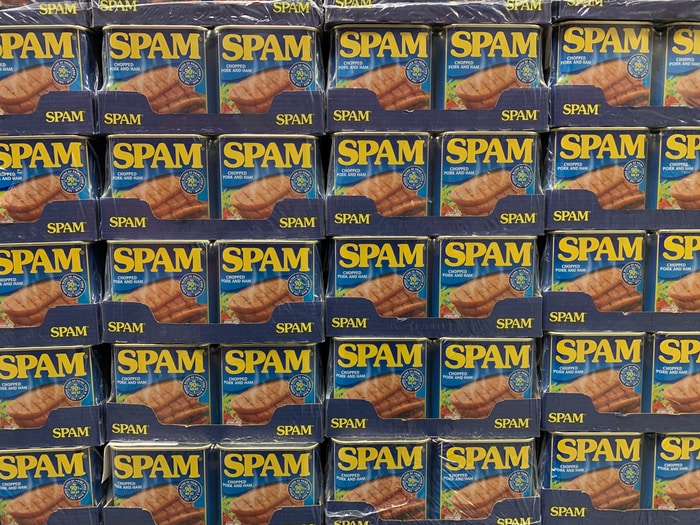It’s the question that’s on everyone’s mind: is spam gluten free? The answer, as it turns out, is a little complicated. Spam is made from pork shoulder and ham, both of which are typically gluten free. However, the spam may also be injected with a wheat-based filler, which would make it not gluten free. So, if you’re looking to avoid gluten, it’s best to check the ingredient list before buying spam.

What Is Spam?
Spam, in its most basic form, is a type of processed meat product made from pork shoulder and ham. It was first introduced to the world in 1937 and became wildly popular during World War II, when it was included in soldier’s rations. The name “spam” stand for “Scientifically Processed Animal Matter”.
While this may sound like something you’d find at your local grocery store, the actual ingredients are much more interesting than that. For one thing, they’re not even close to what we think of as typical American meats.
As any self-respecting Filipino or Italian would tell you, spams aren’t just made out of pork; they also contain beef, chicken, fish, shellfish, and other exotic meats.
What Are the Different Types of Spam Food?
It’s no secret that spam is a popular food choice. It can be found in grocery stores, convenience stores, and even some restaurants. But what many people don’t know is that there are different types of spam.
- Classic spam, which is made from pork shoulder, ham, and salt.
- Turkey spam, which is made from ground turkey and spices.
- Beef spam, which is made from beef and spices.
What Is Spam Made out Of
Spam is a processed meat product that is made from pork that has been treated with a form of sodium nitrite. The end result is a pink and fatty sausage-like product that can be found in many supermarkets. What are the ingredients in Spam?
Meat
Spam is a processed meat product that is usually made from pork, although turkey and chicken spam are also available. The main ingredient in spam is meat, which is why it has a strong and distinct flavor.
Fat
While Spam might be a cheap and easy way to get protein, it’s also high in fat. A three-ounce serving of Spam contains about 17 grams of fat, most of which is unhealthy saturated fat. That’s more than half the daily recommended amount for adults.
Sodium
Most people know that eating too much salt can be bad for your health, but what many don’t know is that a large amount of sodium is also found in spam. In fact, a single serving of spam can contain more than 1,500 milligrams of sodium – more than half the recommended daily limit for adults. This high level of sodium can contribute to high blood pressure and an increased risk of heart disease.
Additives
When most people think of Spam, they think of a cheap, processed meat that is high in sodium. But, do you know that Spam also contains a variety of additives. These additives can include sugar, nitrates, and MSG. While the amount of each additive varies depending on the specific recipe, all of them are unhealthy and can cause problems such as obesity and cancer.
Nutrition and Health Concerns with Spam
Spam is a processed meat that has been around since the early 1900s. It is made from pork shoulder, ham, and salt. The high levels of sodium in spam make it a food to avoid, especially if you are concerned about your heart health.
Spam is also high in saturated fat and cholesterol, which can raise your risk for heart disease. In addition to these negative effects on your body, spam is packed full of preservatives like potassium sorbate, sodium benzoate, and other chemicals. These additives may be harmful to our bodies as they have never been proven safe by the FDA.
Healthy Alternatives to Spam
People are always looking for healthy alternatives to spam food. Unfortunately, many of the substitutes that have been touted as healthy are actually not very good for you. Here are some healthier alternatives to spam that you can try:
Plant-Based Meat Alternatives To Spam
There are many plant-based meat alternatives on the market today. Some of these include Beyond Meat, Gardein, and Tofurky. These products are made with soy, wheat, or other plant-based proteins. They are healthier than spam food because they are low in fat and cholesterol and high in fiber. Plant-based meats also taste good, which makes them a popular choice for vegetarians and vegans.
Seafood Alternatives To Spam
One of the most popular lunches for people on the go is Spam. It is easy to make, and it is affordable. However, there are healthier alternatives to Spam that you can eat. Tuna salad is one alternative to Spam. It is also easy to make, and it is affordable. Another alternative to Spam is salmon salad. It also easy to make, and it is affordable. If you are looking for a more exotic option, you can try shrimp salad. It is also easy to make, and it is affordable.

The History of Spam
Spam was invented in the early 1900s. It was created when a food company combined pork shoulder, ham, and bacon, and then canned it. Spam became popular during World War II, when it was served to troops overseas.
After that time, people started using it for other purposes such as sandwiches or even breakfast foods. In recent years, there have been several different types of spam products on the market. Some companies sell their own brand of spam while others buy the product from another manufacturer.
Is Spam and Luncheon Meat the Same?
Spam and luncheon meat are often used interchangeably, but they are not the same. Spam is a processed pork product that was created in the 1930s. Luncheon meat is a type of sliced meat that can be made from beef, pork, turkey, or chicken. It is usually sold in cans or tubes.
The main difference between these two products is that one has preservatives added to make it last longer than the other. While both contain salt, sugar, water, fat, and sodium nitrite, only spams are treated with an oxidizing agent which makes them brown when cooked.
Is Spam Food Good for You?
Spam has been around for over 75 years and is a popular food in the United States. Some people believe that spam is healthy because it is low in fat and high in protein.
However, spam is also high in sodium and other additives that may not be good for you. Spam should not replace regular meat as part of your diet; however, if you like eating ham but don’t want all the extra calories from bacon, then consider trying spam instead.









